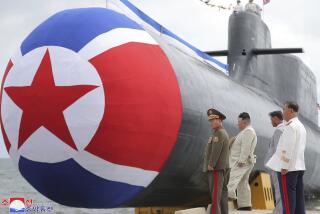Small Submarines Test Silent, Test Deep in Mysterious Idaho Lake
- Share via
BAYVIEW, Idaho — Missile submarines were by definition beyond any control from land. Their entire mission was to disappear.
--The Hunt for Red October, by Tom Clancy
****
Dave Pierce likes to play with model boats. Model submarines, actually--up to 88 feet long.
A guy needs a very big bathtub for models on that scale, and the Navy officer has just the place--Lake Pend Oreille, which meanders 43 miles through the timbered slopes of the Selkirk Mountains.
Pierce commands a submarine research base where, years after the end of the Cold War, the U.S. Navy is still perfecting the Hunt for Red October.
Northern Idaho may seem an unlikely place for one of the nation’s most advanced submarine test sites. But the Navy came for the waters, said to be perfect for running silent and running deep.
The lake reaches depths of 1,100 feet, with a constant subsurface temperature of 39.5 degrees. Since temperature affects the speed of sound, that steadiness is important for taking consistent measurements of noise.
Because the government owns most of the land surrounding the lake, there is little development along the forested shoreline. So the area is ideal for testing submarine design. “There is no lake like this anywhere in the world,” says Pierce, a lieutenant commander.
And, despite the end of the Cold War, the Navy still has a job to do, says Tom Warring, a spokesman for the Naval Surface Warfare Center in Maryland.
“The collapse of the Soviet Union doesn’t mean subs are going away,” he says. “Iranians own submarines. Indians own submarines. There are a lot more submarine owners than there used to be.”
The Navy’s acoustic research detachment plays a key role in the quest for ever-quieter submarines. It’s the only active-duty remnant of the former Farragut Naval Training Center, established during World War II to train 293,000 sailors. In 1946, most of the center’s 4,000 acres became Farragut State Park.
The remaining base covers just 22 acres along the lake’s south end, near this resort community of 300 people. The fleet of remote-controlled model submarines is housed in sheds built over the lake.
Though model subs are deployed for weeks and tracked by underwater microphones, they have almost no effect on recreational boating. “We test at night because there are fewer boats and the winds die down,” says Henry Netzer, the base’s senior civilian engineer.
Many tests are conducted in mid-lake, in 26 square miles far from most people, he says. Occasionally researchers ask boaters to leave if noise from their craft threatens the tests.
“By and large, the Navy here is real cooperative,” says Kevin Elmore, who works at a Bayview resort. “The subs go around the lake 10 or 12 miles from here, out in the middle of no-man’s land. We only see them go in and out.”
The Navy is good for business, says Ruby Tidwell, owner of the Bayview Scenic Hotel. “Navy personnel stay here. They can walk to the motel.”
Over the years, the base’s mission has sparked rumors and dark fantasies. Some locals believe a secret underwater river provides the gateway for full-size subs from the Pacific Ocean, about 300 miles away. Another legend links the base and a mythical underwater beast named Pondy.
Pierce, an acoustic engineer, had never heard of the base before taking command about a year ago. But others knew that the site plays a key role in developing future classes of submarines.
At a ceremony last year, Rear Adm. Edmund Giambastiani, director of the Navy’s submarine warfare division, called Pend Oreille the submarine force’s “most important body of water.”
Testing models rather than full-size subs has saved about $1 billion in development costs, he estimates.
Workers at the base operate unmanned models up to 88 feet long--about one-quarter the length of a full-size sub. These days, they’re testing the Navy’s new nuclear attack submarine class.
How quickly and quietly do these vessels go? How deep can they dive?
That’s classified, says Pierce, sole naval officer at a base that employs about 130 civilians.
Submarines have always survived on stealth, and modern subs are amazingly quiet. A decade ago, when models for the Seawolf class were tested, one model was painted before the trials, Pierce recalls.
When tests showed an unacceptably high noise level, researchers blamed the paint job. “A bristle of the paintbrush used to paint the surface had been left on the dome,” he says, describing the front of the sub. “One bristle had overcome the design.”
Work is underway on an $8-million structure to house five submarine models, including the world’s largest: a 120-foot mini-version of a new attack submarine.
The $50-million model will be called Cutthroat, a name selected by children at nearby Athol Elementary School to honor local trout. Built jointly by Newport News Shipbuilding and Electric Boat, the model will be assembled in the new building--what Netzer calls a first for the base.
Besides being classified, the tests at Bayview are unobtrusive. Models are not armed, and no weapons are fired. Though the base has drawn anti-nuclear protesters, it has no nuclear facilities.
The base thrives on the calm and has never lost a model in the lake’s vast waters. “That,” Pierce says, “would be a bad thing.”
More to Read
Sign up for Essential California
The most important California stories and recommendations in your inbox every morning.
You may occasionally receive promotional content from the Los Angeles Times.













